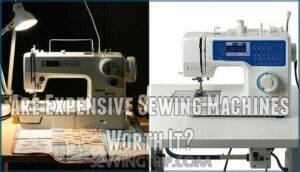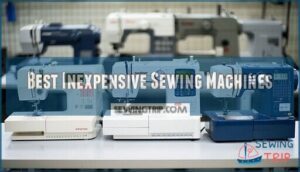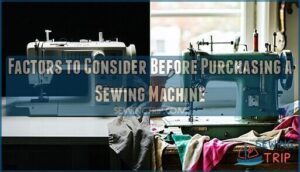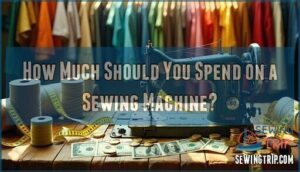This site is supported by our readers. We may earn a commission, at no cost to you, if you purchase through links.
 You’re staring at that $3,000 sewing machine wondering if you’ve lost your mind, right?
You’re staring at that $3,000 sewing machine wondering if you’ve lost your mind, right?
Here’s the deal: expensive sewing machines are worth it if you’re serious about your craft.
They’ll give you precise stitching, handle heavy fabrics like butter, and won’t throw tantrums when you’re racing against a deadline.
Think of it like buying a sports car versus a bicycle – both get you places, but one makes the journey smoother.
If you’re hemming curtains twice a year, stick with budget models.
But if you’re tackling quilts, garments, or running a business, premium machines pay for themselves through reliability and professional results that’ll make your wallet sing later.
Table Of Contents
- Key Takeaways
- Why Are Sewing Machines So Expensive?
- Expensive Sewing Machine Brands
- Most Expensive Sewing Machines
- Best Inexpensive Sewing Machines
- Factors to Consider Before Purchasing a Sewing Machine
- How Much Should You Spend on a Sewing Machine?
- Are Expensive Sewing Machines Worth It?
- Frequently Asked Questions (FAQs)
- Conclusion
Key Takeaways
- You’ll get what you pay for – expensive sewing machines deliver precise stitching, handle heavy fabrics effortlessly, and won’t break down when you’re racing against deadlines, making them worthwhile investments for serious sewers.
- Your sewing frequency determines value – if you’re stitching weekly or running a business, premium machines pay for themselves through reliability and professional results, but occasional hobbyists should stick with budget models under $400.
- Quality matters more than price tags – premium brands like Janome, Bernina, and Juki use metal components instead of plastic, offer advanced computerized features, and typically outlast budget machines by years, justifying their higher costs.
- Match your investment to your skill level – beginners don’t need $2,000 machines to learn basics, but experienced sewers working on complex projects like quilting or garment construction will appreciate the precision and durability that high-end machines provide.
Why Are Sewing Machines So Expensive?
Ever wonder why that dream sewing machine costs more than your monthly rent? The price tag isn’t just marketing fluff – it’s about serious engineering and premium materials.
Material costs drive up prices substantially. High-end sewing machines use metal components instead of plastic, ensuring they’ll handle heavy fabrics without breaking a sweat. Manufacturing location matters too – machines built in countries with higher labor costs reflect that in their pricing.
Metal beats plastic every time—your machine needs to handle denim like a champ, not crumble under pressure.
Feature complexity adds serious value. You’re paying for computerized brains that remember your favorite stitches, automatic thread cutters that save time, and embroidery capabilities** that turn fabric into art. This isn’t your grandmother’s basic machine.
Brand reputation commands premium pricing. Companies like Bernina and Janome invest heavily in R&D, creating innovative features that justify their expensive sewing machines. Their sewing machine investment includes decades of engineering expertise, global service networks, and quality guarantees that make the sewing machine cost worthwhile for serious crafters.
Expensive Sewing Machine Brands
Understanding what drives those hefty price tags helps you appreciate why certain brands command premium pricing.
When you’re considering expensive sewing machines, you’re really investing in decades of engineering excellence and innovation.
Here are the top three brands that justify their high-end sewing machine reputation:
- Janome History – Since 1918, this Japanese manufacturer has pioneered programmable home machines.
- Bernina Quality – Swiss engineering doesn’t come cheap, but you’re getting luxury-grade construction.
- Juki Durability – Built for industrial-strength performance, these machines feature steel frames designed for high-volume sewing.
Their sewing machine investment pays off with models like the 3160QDC-T ($999) offering computerized precision and reliability that’ll last for years.
Expect to spend $1,000-$15,000 for their premium computerized models with custom programming capabilities.
Models like the HZL-F300 ($1,499) bring commercial-grade reliability to your home studio.
The Juki TL 2010Q, for example, is designed for quilting and improved efficiency.
These best sewing machine brands earn their reputation through consistent performance, advanced features, and long-term durability that makes the initial investment worthwhile for serious sewers.
Most Expensive Sewing Machines
Premium sewing machines can cost more than a decent used car, and honestly, they’re worth every penny for serious sewers.
You’ll find expensive sewing machines like the Janome Memory Craft 15000 pushing $8,000, while Bernina’s top models reach $15,000.
These high-end sewing machines aren’t just showing off – they pack luxury machine features that professionals actually need.
Think whisper-quiet motors, 1,000+ built-in stitches, laser guides, and computerized embroidery systems.
Exclusive machine brands like Pfaff and Viking deliver high-end durability that’ll outlast cheaper alternatives by decades.
For professional sewing needs, investment justification becomes clear when you’re cranking out custom work daily.
Sure, your grandmother’s machine worked fine, but these modern marvels transform sewing from tedious task to pure artistry.
Sewing machine value here means buying once, not replacing constantly.
Best Inexpensive Sewing Machines
Budget-conscious sewers shouldn’t feel shortchanged when shopping for their first machine.
You’ll find excellent beginner-friendly options that won’t break the bank while delivering solid performance.
The key is focusing on essential features rather than fancy bells and whistles.
Here are five standout affordable machines that tackle sewing machine affordability without sacrificing quality:
- Brother XM2701 – Just over $100 with detailed instruction guides and user-friendly design
- Brother XR3774 – Solidly built with impressive accessories and shared compatibility across Brother models
- Brother ST371HD – Versatile, durable construction perfect for expanding skills while staying portable
- Brother CS7000X – Computerized convenience under $500 with intuitive controls for confidence-building
- Singer Heavy Duty HD500 – Mechanical reliability with retro styling that performs adequately for basic projects
These sewing machine economic alternatives prove you don’t need premium pricing for dependable stitching.
Consider that many reputable brands offer dependable lower-end models.
Focus on maintenance simplicity and durability concerns when choosing your sewing machine for beginners.
Factors to Consider Before Purchasing a Sewing Machine
Before you swipe that credit card on a shiny new sewing machine, you’ll want to think through a few key factors that’ll make or break your stitching happiness.
Think beyond the price tag—your sewing dreams deserve a machine that won’t quit mid-project.
Your sewing frequency, skill level, and project types should guide your decision more than flashy marketing claims or that friend who insists you "absolutely need" the latest computerized wonder.
Full-size Vs. Miniature Sewing Machine
The choice between full-size and miniature sewing machines isn’t just about sewing machine dimensions—it’s about matching your ambitions with reality.
While compact models score points for portability concerns and work well in small spaces, they often struggle with stitch quality and fabric compatibility on demanding projects.
Consider these key differences:
- Workspace capacity – Full-size machines handle large quilts and garments without cramping your style
- Motor power – Heavyweight fabrics need robust motors that mini machines typically lack
- Stability – Sewing machine weight provides steadier stitching, especially at higher speeds
- Feature range – More built-in stitches and settings accommodate diverse project sizes
- User comfort – Ergonomic design reduces fatigue during extended sewing sessions
Your user skill level matters too. Beginners might appreciate a portable sewing machine for learning basics, but serious sewers quickly outgrow miniature limitations.
Computerized Vs. Mechanical Sewing Machine
After deciding on size, you’ll face another key choice: mechanical vs electronic machines.
Mechanical models use dials and knobs, offering straightforward operation with lower power consumption and easier repair difficulty.
They’re perfect for beginners tackling the learning curve without overwhelming feature variety.
Computerized sewing machines bring automation magic—buttons and touchscreens handle stitch complexity effortlessly.
While pricier, these digital workhorses offer extensive sewing machine features and benefits that justify their sewing machine worth for serious sewers seeking advanced capabilities.
They provide a significant advantage in terms of functionality, making them a worthwhile investment for those who plan to use their sewing machine frequently, and can be considered a digital workhorse.
Included Presser Feet
Right out of the box, the presser feet bundled with your machine determine which projects you can tackle immediately. Think of them as your sewing toolkit’s foundation.
- Specialty Feet – Zipper, buttonhole, and hemming feet expand your creative possibilities
- Foot Compatibility – Snap-on systems make switching between feet effortless
- Adjustable Pressure – Fine-tune pressure settings for delicate fabrics like silk
- Foot Storage – Built-in compartments keep sewing machine accessories organized and accessible
Premium models include more feet upfront, while budget machines offer basic sets with aftermarket feet available separately. Understanding different presser foot options can substantially expand your sewing capabilities.
Stitches and Buttonholes
The heart of any sewing machine lies in its stitch repertoire and buttonhole capabilities.
Quality machines offer diverse stitches—from basic straight and zigzag to decorative options for embellishment. Stitch quality directly impacts your project’s professional appearance, while buttonhole automation saves time on garment construction.
Many sewers find value in using a buttonhole sewing machine for garment projects.
- Stitch customization lets you adjust length, width, and tension for perfect results
- Specialty stitches handle stretchy fabrics, quilting, and appliqué with precision
- Decorative stitches transform plain projects into personalized masterpieces with built-in patterns
- Buttonhole automation creates consistent, professional buttonholes without manual measuring or guesswork
Automatic Needle Threader
Threading needles can feel like threading a camel through the eye of a needle—frustrating and time-consuming.
An automatic needle threader changes this game completely, saving precious minutes on every project, especially when switching between different thread colors.
Consider threader reliability and maintenance requirements before investing in expensive sewing machines with this feature.
Many users find an automatic needle threader to be an indispensable tool, delivering genuine value for money.
Some models offer better threader speed and compatibility than others, while threader alternatives exist, this sewing machine feature substantially improves your sewing machine investment worth.
How Much Should You Spend on a Sewing Machine?
In the context of sewing machine budget planning, your wallet doesn’t need to break the bank if you’re strategic about it.
Most beginners find their sweet spot spending $250-$300 for a reliable machine that’ll last years without constant repairs.
Here’s your budget breakdown by sewing goals:
- Occasional hobbyist: $200-$350 gets you solid basics
- Regular sewer: $400-$750 offers significant speed and ease improvements
- Clothing maker: $1,000 total (including serger and cover stitch)
- Quilter: $400+ for larger throat space or professional services
- Beginner experimenting: Under $400 prevents costly mistakes
Your usage frequency drives everything.
Sewing once monthly? Don’t splurge on expensive sewing machines with bells and whistles.
Daily stitching? That $750 investment pays dividends in frustration saved.
Match your skill level to features you’ll actually use.
A computerized powerhouse won’t improve your straight stitch if you’re still learning basics.
Are Expensive Sewing Machines Worth It?
Looking beyond the sticker shock, expensive sewing machines aren’t just fancy gadgets—they’re investments that pay dividends for the right sewers. Your skill level matters most here.
Beginners don’t need a $2,000 Bernina to learn straight stitches, but experienced sewers will appreciate the precision and durability that high-end sewing machines deliver.
Project complexity plays a huge role too. Quilting intricate patterns or working with heavy denim demands more muscle than hemming curtains.
Sewing frequency is the real deal-breaker. If you’re stitching weekly, that expensive machine becomes a justified investment through time saved and frustration avoided.
Budget alignment means being honest about what you can afford versus what you actually need. The long-term value of sewing machine performance and durability often trumps upfront costs.
Premium machines typically outlast budget models by years, making sewing machine value for money a marathon, not a sprint. Investing in a machine with superior stitch quality is a key consideration.
Frequently Asked Questions (FAQs)
Do you need an expensive sewing machine?
You don’t necessarily need an expensive sewing machine.
Your needs determine the right choice.
Budget models work fine for beginners and occasional projects, while premium machines benefit frequent sewers who value automation and advanced features.
Does a good sewing machine make a difference?
A quality machine delivers consistent stitches, handles various fabrics smoothly, and reduces frustration. You’ll spend less time fighting with tension issues and more time creating beautiful projects you’re proud of.
How much should a good sewing machine cost?
You’ll find decent sewing machines starting around $200-400 for beginners, while experienced sewers benefit from $500-1,500 models.
Your budget should match your sewing frequency—occasional use needs less investment than daily projects, considering daily projects.
What is the most reliable brand of sewing machine?
Janome boasts an impressive 100+ year track record since
You’ll find their machines consistently outlast competitors, with Brother and Bernina close behind.
Industrial-grade Juki models dominate factories worldwide for their bulletproof reliability.
What benefits do laser-guided sewing machines offer?
Laser-guided sewing machines project precise lines onto your fabric, helping you maintain straight seams and accurate spacing.
You’ll reduce guesswork, improve consistency, and work faster on quilting projects, hemming, and topstitching tasks.
How does stitch customization enhance sewing accuracy?
Think of stitch customization as your sewing GPS—it guides you precisely where you need to go.
You’ll adjust length, width, and tension to match your fabric perfectly, eliminating puckering and ensuring professional-looking seams every time.
Are premium machines suitable for small-scale projects?
Premium machines absolutely work for small projects, but you’re bringing a Ferrari to a grocery run.
They’ll handle delicate fabrics beautifully and speed up even simple tasks, though you won’t use most features.
How do advanced features affect learning curves?
Surprisingly, advanced features can actually flatten your learning curve.
You’ll master techniques faster when automation handles tedious tasks, letting you focus on creativity and skill-building rather than wrestling with mechanical adjustments.
Does build quality vary across premium models?
Yes, build quality varies substantially among premium models.
You’ll find differences in motor power, frame materials, precision engineering, and component durability.
Research specific brands and models carefully—not all expensive machines deliver equal craftsmanship.
Conclusion
Ironically, asking "are expensive sewing machines worth it" is like wondering if good tools matter to a carpenter.
You’ve got your answer: they’re worth every penny if you’re committed to quality work.
Cheap machines will frustrate you faster than tangled thread, while premium models deliver precision and durability that’ll outlast your next three hobbies.
Match your investment to your ambition – casual sewers can stick with budget options, but serious crafters shouldn’t compromise on quality.
- http://www.stylomagazine.com/magazine.html
- https://ismacs.net/singer_sewing_machine_company/singer_turtle_back_model_sewing_machine.html
- https://www.quora.com/What-are-the-pros-and-cons-of-buying-an-expensive-sewing-machine-Is-the-quality-and-reliability-worth-the-extra-cost
- https://www.premierstitching.com/blog/how-do-cheap-sewing-machines-compare-to-expensive-machines/?srsltid=AfmBOooniNiuyl0AEiydAWJuorVM50uBNwBbetTjbftrfLVxkTB3BM_-
- https://www.reddit.com/r/sewhelp/comments/ya934t/your_opinion_wanted_is_a_higher_end_sewing/









